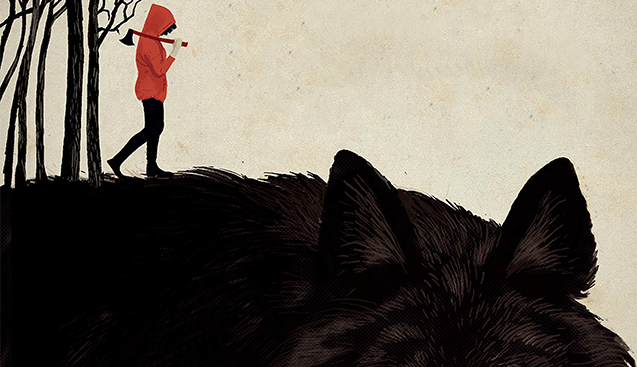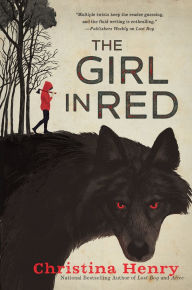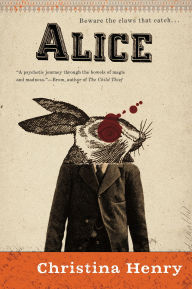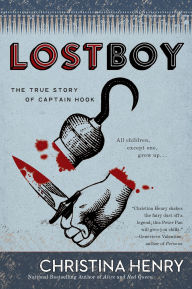Christina Henry’s The Girl in Red Is Not Afraid of the Big Bad Wolf
 Christina Henry, the author of the Black Wings urban fantasy series, has, in the past several years, shifted her focus toward retold fairy tales, from Alice and Red Queen—dark, skewed takes on Lewis Caroll’s iconic Alice in Wonderland—to Lost Boy: The True Story of Captain Hook, the decidedly un-Disney The Mermaid, and, now, the revisionist fun of The Girl in Red, which is not the retelling of Little Red Riding Hood you might expect—which is what makes it so interesting.
Christina Henry, the author of the Black Wings urban fantasy series, has, in the past several years, shifted her focus toward retold fairy tales, from Alice and Red Queen—dark, skewed takes on Lewis Caroll’s iconic Alice in Wonderland—to Lost Boy: The True Story of Captain Hook, the decidedly un-Disney The Mermaid, and, now, the revisionist fun of The Girl in Red, which is not the retelling of Little Red Riding Hood you might expect—which is what makes it so interesting.
The Girl in Red
The Girl in Red
In Stock Online
Paperback $19.00
It’s about Red, a woman on her own, surviving against all odds in a United States decimated by a widespread epidemic known as the Cough. Red is a biracial girl in her twenties, a polymath with a prosthetic leg. She also has an extreme anxiety disorder, and though she attempts to not let these things define her, it’s ultimately what preoccupies her throughout the novel.
It’s about Red, a woman on her own, surviving against all odds in a United States decimated by a widespread epidemic known as the Cough. Red is a biracial girl in her twenties, a polymath with a prosthetic leg. She also has an extreme anxiety disorder, and though she attempts to not let these things define her, it’s ultimately what preoccupies her throughout the novel.
The narrative unfolds out of sequence. When we first meet Red, she’s already killed to survive, and she’s more than ready to kill again when a lone stranger appears at her campsite in the woods. If we think this man is the analogue of the wolf in the fairy tale, Red surprises us by taking him out immediately. So what is the wolf in this tale? It could very easily be the sickness that’s taken out most of the population, or the rogue militias that have begun to wreak violent havoc on the small towns she’s forced to cross through in search of food. It could be the military, which is rounding up people immune to the disease and forcing them into quarantine camps. It could also be the mysterious reason behind why corpses are appearing with blown out chest cavities, which is hardly a symptom of the Cough.
Alice
Alice
In Stock Online
Paperback $19.00
As Red travels through the pockets of wilderness that dot the ravaged United States on a 200-mile journey to her grandmother’s house, she reflects back on how she got to this point in her life, answering the question of why she’s so alone along the way. It’s a story of family and loss, but as she meets two lost children in the woods, as well as an elderly man who’s managed to evade both the militia and the government while waiting for his own grandchildren to arrive, it becomes one of hope and survival.
As Red travels through the pockets of wilderness that dot the ravaged United States on a 200-mile journey to her grandmother’s house, she reflects back on how she got to this point in her life, answering the question of why she’s so alone along the way. It’s a story of family and loss, but as she meets two lost children in the woods, as well as an elderly man who’s managed to evade both the militia and the government while waiting for his own grandchildren to arrive, it becomes one of hope and survival.
Red, as a character, sees a lot of growth through the seven-week period of her journey. At first, she’s anxious and suspicious of everyone and everything, which is not an unproductive stance to take in this world, but it makes for a very lonely trip. Red spends most of the first leg of her trip alone with her thoughts and trying so hard to avoid thinking her painful past, including unspoken events involving her brother.
Lost Boy: The True Story of Captain Hook
Lost Boy: The True Story of Captain Hook
In Stock Online
Paperback $19.00
A chance encounter with two desperate children alleviates her loneliness, but it’s also a major turning point for her, helping her go of her obsessive and often paralyzing anxiety in order to think about what’s best for them—which often involves travel into more dangerous zones to find food and supplies. As Red realizes that there is more to life than survival, she’s able to step out of her own head and her own comfort zone, such that it is considering she inhabits a dangerous post-apocalyptic world. Her fairy tale story takes her from scared kid to take-charge adult, full of feminist rage.
A chance encounter with two desperate children alleviates her loneliness, but it’s also a major turning point for her, helping her go of her obsessive and often paralyzing anxiety in order to think about what’s best for them—which often involves travel into more dangerous zones to find food and supplies. As Red realizes that there is more to life than survival, she’s able to step out of her own head and her own comfort zone, such that it is considering she inhabits a dangerous post-apocalyptic world. Her fairy tale story takes her from scared kid to take-charge adult, full of feminist rage.
I rarely say this about a book, but I wish that this one had been longer. I am eager to see how Red handles her newfound adulthood over the days and weeks to come. The story ends abruptly and with questions left unanswered, because it is, after all, about Red’s journey into adulthood more than the reveals behind its science-fictional elements. As Red points out numerous times, her real life is not a horror movie. Not all the threads of a life are neatly tied up as we go through our own journeys of growth and change.
So who is the big bad wolf of this tale? Turns out there isn’t just one. There are many. It’s a journey worth taking alongside Red as she faces down them all.


